The piece of the month of November 2024
SOME VIEWS OF NAVARRA BY DIDIER PETIT DE MEURVILLE
Eduardo Morales Solchaga
Chair of Navarrese Heritage and Art
The Provincial Council of Gipuzkoa has a cultural website called "Álbum siglo XIX" which houses an interesting collection of more than 4,000 illustrations belonging to the institution, located in different cultural centers dependent on it. Browsing through it, one can find many images related to Navarre and the Navarrese, highlighting for their plasticity some of the watercolors and drawings related to localities of the Navarre territory. Among them are several made by a picturesque character of the nineteenth century, Didier Petit de Meurville, which is worth stopping.
Biographical approach
François-Didier Petit de Meurville (1793-1873) came from a family of noble ancestry and was born in the French colony of Haiti where his father, consul in those latitudes, was assassinated in the slave revolution of 1794. His family, ruined, escaped to Baltimore (Maryland-United States), where a colony of French exiles had been created. Ten years later they returned to France, setting up their residency program in a 17th century building known as la Sablière, in Lyon.
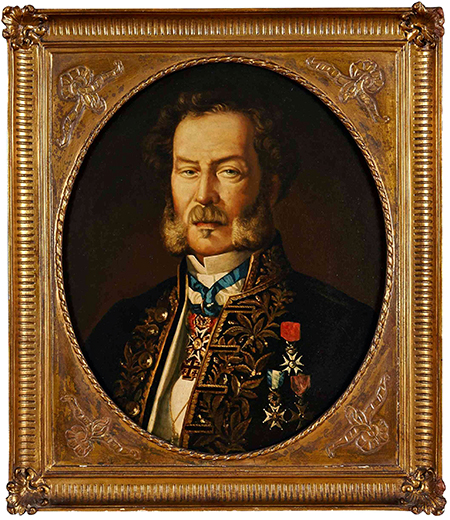
Portrait of Didier Petit de Meurville
Petit de Meurville started there an embroidery and tapestry manufacture known in France for the richness of its fabrics and for the incorporation of the latest technology of the time, the Jacquard loom, which introduced automation through a proto-computerized system of perforated cards. His looms produced commissions for Charles X Louis-Philippe of Orleans, among many other illustrious personalities. At the same time, he combined the family business with his facet as a collector of works of art, accumulating a considerable collection valued at the enormous sum of 120,000 francs of the time, which was published in the form of an inventory in 1843. His reputation as a collector allowed him to participate in the intellectual circles of the time in the famous salons and to visit the most important European exhibitions.
At the same time, he helped the pretender Don Carlos María Isidro de Borbón and his followers, who did not have it easy during their exile in France, turning the Sablière into a place of meeting for the main leaders of the traditionalist movement, whom he had the opportunity to portray on several occasions. In response to this, the self-proclaimed Charles V granted him in 1845 the degree scroll of Viscount of Amparo, also sponsoring one of his sons.
Unfortunately, financial problems affected his business from the 1940s onwards, and he was forced to sell a large part of his collection in order to refund a substantial loan mortgage contracted in 1837. In any case, it was all in vain, and by 1847 he was broke and destitute, having to resort to his mother's financial aid .
This status, added to the proclamation of the Second French Republic, encouraged him to redirect his professional degree program -following the family tradition- towards diplomacy, being appointed Vice Consul of France in Alicante in 1848. In parallel to his representation work, Didier was passionate about painting and drawing, with special attention to the landscape and the local flora of Gipuzkoa, of which numerous testimonies are preserved in canvases and especially in drawings and watercolors, many of them forming part of albums. Along with these genres, he also cultivated portraits in small format, usually on paper. His figure joins that of other foreign artists who, after the War of Independence and in the following decades, found in Spain the ideal model for romantic painting due to the peculiar exotic beauty of the ancient and medieval vestiges preserved, without leaving aside the Andalusian influence in the Levantine area.
In June 1857 he was elevated to Consul in San Sebastian, after a mediation by Madame de Lamartine, wife of the Minister of Foreign Affairs, which was based on the state of health of Petit de Meurville's wife and the need for higher emoluments, since they had to support twelve children at position. After the transfer, he carried out this work punctually until his retirement in 1872. He was decorated with the Order of Charles III of Spain for having faithfully served the dynasty he once despised, and also received the National Order of the Legion of Honor for his extraordinary merits in the performance of his civilian duties. He died a year after his retirement, due to a stroke during a stay in Biarritz.
Your trip to Pamplona
At the end of April 1858, he entered the territory accompanied by his son Henri-Georges, who had been appointed vice-consul in Pamplona and began a diplomatic degree program that would later lead him to hold the consulate general of Venezuela and to exercise, also as consul, in Tampico (Mexico). His other son, François-Xavier, again following the family tradition, also worked as vice consul in Torrevieja (Alicante).
Be that as it may, Petit de Meurville "father" made different drawings of the route from San Sebastian on a small notebook, preserved in its entirety in private hands. Of the road, as he himself indicates, he took two partial views from the interior of two villages on the old road to San Sebastian. Although its hamlet is not particularly identifiable, in the second case it is undoubtedly Lecumberri, since in the foreground we can see the Astiztonea house, with three levels and an attic, with a semicircular arch in the main entrance. The entire central part has the typical triangular stone framing of the Larráun area. Currently it presents substantial modifications, since the lateral addition has been suppressed and the two balconies that appear in the drawing have been substituted by others of new invoice, located in the second floor on both sides of the central body, widening the openings for it. The door on the right has also been replaced by a small window. Behind the mansion, the crown of the tower of the parish of San Juan Baustista can be seen, an element that can no longer be seen from this location at present, since a building has been built next to the one drawn by the French diplomat.
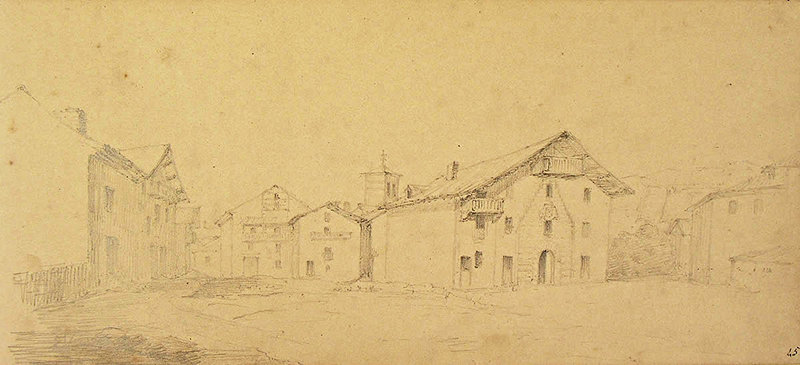
View of Lecumberri. NO. 2727.
By April 28, as can be seen in his notebook notes, he was already in Pamplona, where he made two pen drawings, watercolored in brownish tones and enhanced with white touches, using gouache. The first view, taken from near the convent of San Pedro de la Rochapea, focuses almost exclusively on the back of the cathedral, between the bastions of Labrit and Redín. In the foreground, and preceding the city's profile , is the medieval bridge of San Pedro, the oldest in the capital, built in the 12th century, possibly on the site of a Roman original. It is very reminiscent of an anonymous lithograph that accompanied a article of the Illustrated London News published in the previous decade dedicated to the imprisonment in the citadel of the progressive politician Salustiano de Olózaga.
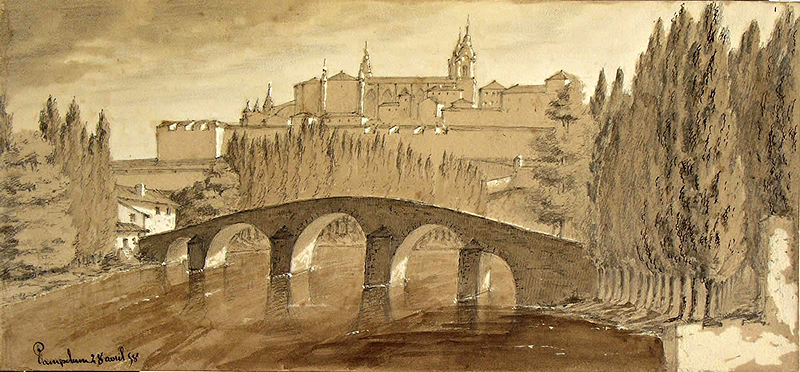
View of the cathedral of Pamplona from the bridge of San Pedro. NO. 2836.
That same day, and with the same technique and style, he portrayed a southern view of the capital, preceded by the esplanade that forms the glacis of the citadel and under the watchful eye of the San Cristóbal mountain. Recognizable -from left to right- are what appears to be the convent of the Augustinian Recollect nuns, the old turreted façade of the parish of San Lorenzo and the chapel of San Fermín, and the towers of San Saturnino and San Nicolás. At the far end, and following the tree-lined path, the portal of San Nicolás and the basilica of San Ignacio can be glimpsed - very faintly - and the towers of the cathedral can be seen behind.
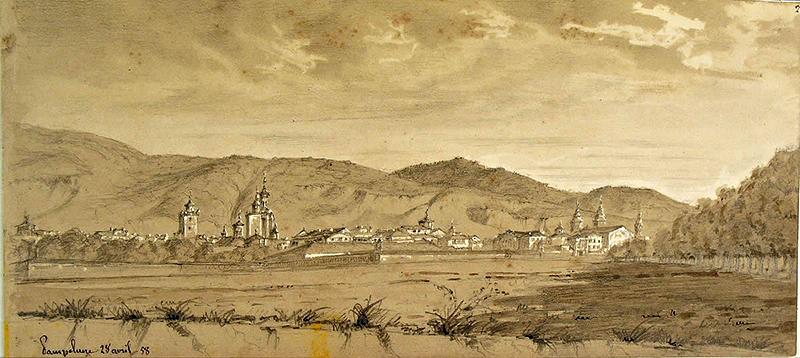
Southern view of Pamplona. NO. 2839.
The third view, probably taken during the same workshop and which is more interesting, is a graphite drawing made with care and attention to detail in which the city of Pamplona can be seen from the area then known as "Los cuatro caminos" (Ripa de Beloso), also showing its bastioned enclosure and, to the left, the citadel. The cathedral and the towers of the parish churches of San Saturnino, San Nicolás and San Lorenzo are recognizable. In the foreground there is also a romantic and popular scene that gives the town a genuine romanticism. The Arga and the mountains of the Cuenca host a composition that will become the favorite horizon of the capital, not only in the last third of the nineteenth century, but also for much of the next century. Back in San Sebastian, this sketch served as the basis for a beautiful watercolor, a real whim in which his skills as a draftsman are clearly reflected.
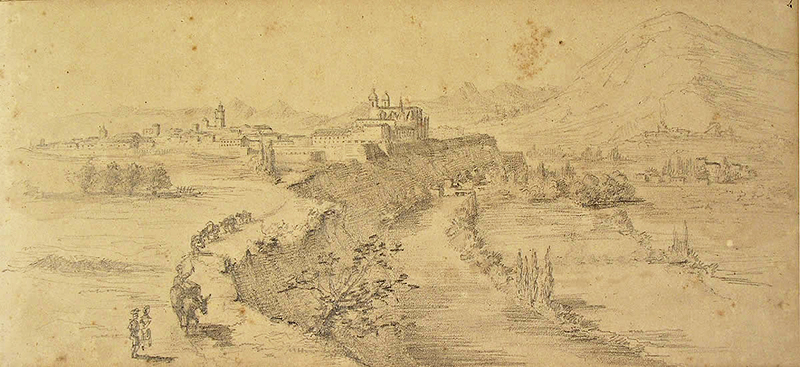
View of Pamplona from the Ripa de Beloso (note). NO. 2714.
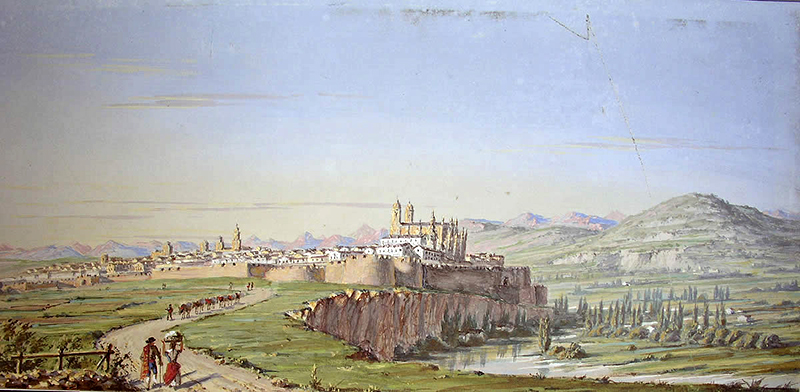
View of Pamplona from the Ripa de Beloso (watercolor). NO. 2896.
He must have also finished at that time and with the same style and technique another watercolor in which a view of the slope of Santo Domingo can be seen, dominated by the old hospital of Nuestra Señora de la Misericordia, a 16th century foundation and today the seat of the Museum of Navarre. Its Renaissance façade with its triumphal arch, which is still preserved today as an entrance, stands out. On the other hand, the adjoining chapel has its old doorway in the form of a humilladero of Gothic ogives and closed by a simple gate. It was replaced in 1934 by another baroque one in the form of an altarpiece, coming from the church of the Soledad Puente la Reina. On the left margin the access of the portal of the Rochapea that was eliminated in 1914 is appreciated and, in the distance, on the skirts of San Cristóbal, the profile of Artica is glimpsed. Picturesque characters make the composition more pleasant, as in the previous example.
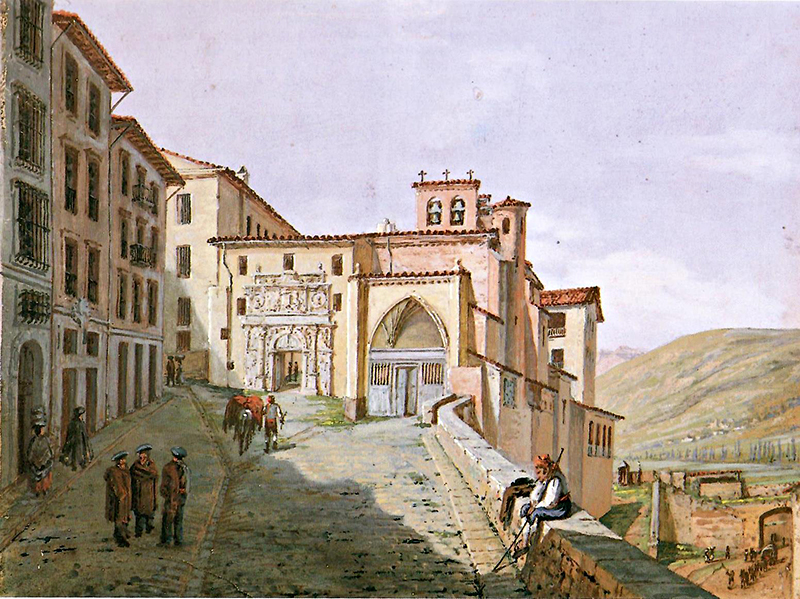
View of the slope of Santo Domingo. Pamplona.
On his way back to San Sebastian and leaving the Basin, on April 30, he also portrayed the famous and unmistakable gorge of Dos Hermanas, located in the Irurzun area, at the end of the Andía mountain range, and connecting to the south with the Araquil valley and to the north with those of Larráun and Basaburúa Menor.
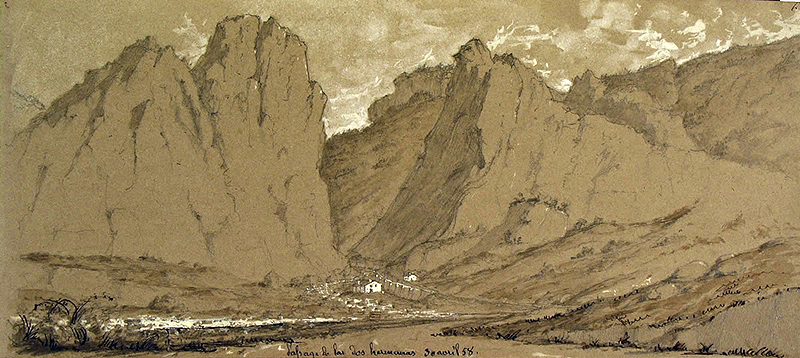
Dos Hermanas Pass. NO. 2844.
Simultaneously he made a sketch graduate "Irurzun", which is really the profile of Sarasa and its hamlet, settled on the slopes of Mount Ollarco, whose orography is also portrayed in detail. In the panoramic view, on one side stands out the -today battered- armory palace, of medieval origins, with its characteristic attached prismatic tower; and on the other, the parish church of San Martín, seated on a promontory and representative of late rural Gothic, although masked by an eighteenth-century portico of three bays articulated in two levels. The scene is completed, as in the profile of Pamplona, by locals from all walks of life. On his return, using these sketches, he made a small full-color watercolor, as in the case of Pamplona, in which a very dynamic and careful technique is used.
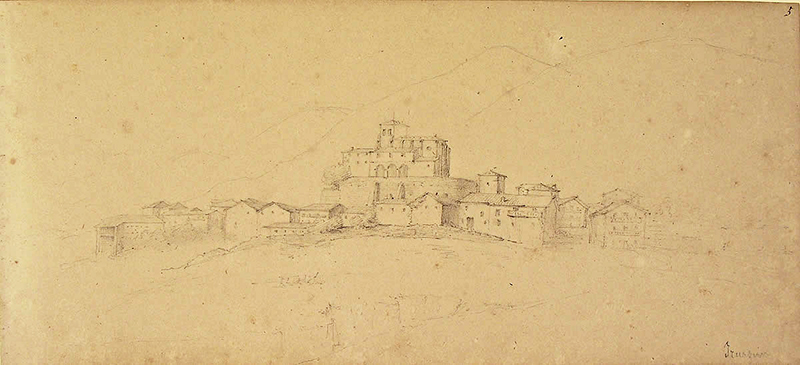
View of Sarasa (note). NO. 2715.
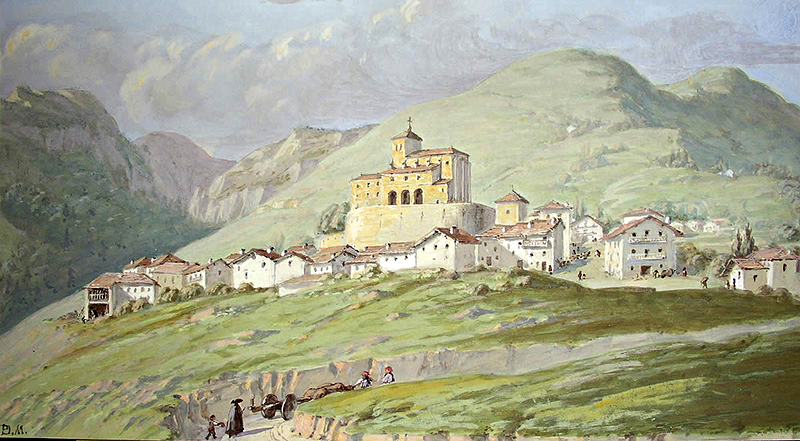
View of Sarasa (watercolor). NO. 2894.
SOURCES AND BIBLIOGRAPHY
Nineteenth century album, cultural website of the funds of the Provincial Council of Gipuzkoa. The inventory numbers of each image are in the corresponding caption.
ALTUBE, F., Guipúzcoa-San Sebastián (1857-1873). Didier Petit de Meurville, San Sebastian, Kutxa Foundation, 1994.
AZANZA, J. J. and URRICELQUI, I. J., "La imagen de la catedral de Pamplona en las artes plásticas de los siglos XIX y XX", in Cuadernos de la Chair de Patrimonio y Arte Navarro, n.º 1 (2006), pp. 497-525.
DEHAN, M., Didier Petit de Meurville (1793-1873): suivi de l'histoire abrégée de la Sablière à Caluire-et-Cuire, Gleizé, Editions du Poutan, 2013.
MORALES, E., "La complicada constitución de los horizontes navarros durante el siglo XIX", in La imagen visual de Navarra y sus gentes: de la Edad average a los albores del siglo XX, Pamplona, Catedra de Patrimonio y Arte Navarro, 2022, pp. 41-50.
MORALES, E., "Pamplona. Visiones de una ciudad", in La imagen visual de Navarra y sus gentes: de la Edad average a los albores del siglo XX, Pamplona, Catedra de Patrimonio y Arte Navarro, 2022, pp. 31-50.
VV.AA., Alicante, exotic place. The gaze of Petit de Meurville (1793-1873)., Alicante, Diputación de Alicante/MUBAG, 2021.
